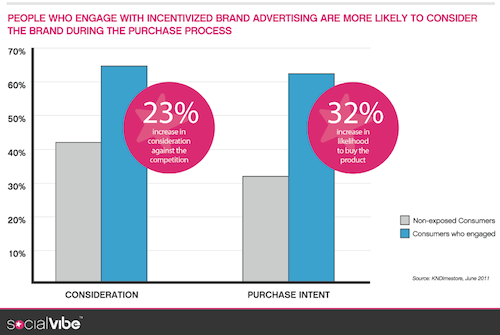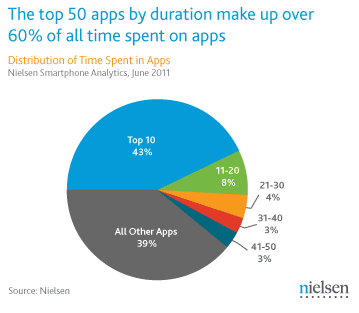Incentivized ads boost brand perception, study finds
 According to a recent study by KN Dimestore and SocialVibe brand messages and incentives influences most consumers to pay more attention to ads. In fact, if companies combine these two advertising and brand strategies, the interaction of consumers with brands increases by 91% and brand perception by 38%.
According to a recent study by KN Dimestore and SocialVibe brand messages and incentives influences most consumers to pay more attention to ads. In fact, if companies combine these two advertising and brand strategies, the interaction of consumers with brands increases by 91% and brand perception by 38%.
The study -which gathers data from more than 30,000 survey respondents- reported that when 48% of survey participants initially opt-in to engage with a brand for the incentive, they stay and pay attention to the brand message.
The aim of the study was to find out if and why incentives prompt people to engage with the advertisements, how they affect consumer perception of the brands, and if they influence people to visit the company’s website or „buzz“ their friends about the offer. Respondents gave feedback on ads from U.S. brands across financial services, CPG, entertainment, e-commerce and technology categories between June and July of 2011.
Some key findings of the study…
48% of those interact because of the incentive but pay attention to brand
12% interact purely based on brand
31% interact for brand and incentive
9% interact purely for the incentive

The results summary makes clear that engaging with the ad increased the odds that the consumers would purchase the product. Above that, incentives through ads drive website and in-store traffic, as well as purchases – and also conversions. Happy customers are coming back more often to the website when initially satisfied with an incentive through incentives. 36% of respondents were more likely to purchase brand-related products at physical store after interacting with the ad.
SocialVibe names the strategy “value-exchange brand advertising”. The company defines it as ads that ask for a consumer’s attention in exchange for something they want, such as virtual currency for social games or making a donation to charity. There is a clear differentiation from sign-up and straight purchase intended offers like cost-per-action (CPA) advertising.
Spot On!
The study is an interesting step in indicating the value of ads for branding. Generating consumer interest and awareness get’s more and more challenging these days with the masses of advertising we are faced with on a daily basis. Mobile advertising shows some similar development in terms of incentivization and engagement. Often companies said that the value of ads is getting lower as they just value it from a conversion-based ROI perspective. However, the study now shows that earning points, virtual currency or some other rewards finds the atention of customers. That’s when conversion comes into play, and that’s where brands need to foster engagement to a purchase via the right communication tactics.

 Is this a good sign for the acceptance of social media in the business world? The use of Twitter as a business and marketing tool has increased from 31% to 61% among Europe’s top business leaders, finds a recent study by CNBC.
Is this a good sign for the acceptance of social media in the business world? The use of Twitter as a business and marketing tool has increased from 31% to 61% among Europe’s top business leaders, finds a recent study by CNBC.
 The vision of Big Brother is still one that separates the generations. Some are scared, some don’t even see that they are engaged to make things happen. But what happens if Augmented Reality becomes Augmented Humanity and merges the world of tomorrow with Visual Search? What a new form of sensual contextuality and the internet of things means to us, explains
The vision of Big Brother is still one that separates the generations. Some are scared, some don’t even see that they are engaged to make things happen. But what happens if Augmented Reality becomes Augmented Humanity and merges the world of tomorrow with Visual Search? What a new form of sensual contextuality and the internet of things means to us, explains 
 Some years ago, Billy Joel sang his song “Honesty” and I always remember this one first line… “Honesty is such a lonely word. Everyone is so untrue.”. Apparently, it seems that Billy was not quite right with his statement (although he took a different approach to his somng argumentation). It is interesting to see that more and more campaigns seem to pitch with that virtue proof…
Some years ago, Billy Joel sang his song “Honesty” and I always remember this one first line… “Honesty is such a lonely word. Everyone is so untrue.”. Apparently, it seems that Billy was not quite right with his statement (although he took a different approach to his somng argumentation). It is interesting to see that more and more campaigns seem to pitch with that virtue proof…

 Many companies have started showing case studies, infographics, or videos to present their latest Social Media activities. Now, EMC comes up with a great video that explains nicely how the copany leverages the power of the social web.
Many companies have started showing case studies, infographics, or videos to present their latest Social Media activities. Now, EMC comes up with a great video that explains nicely how the copany leverages the power of the social web.